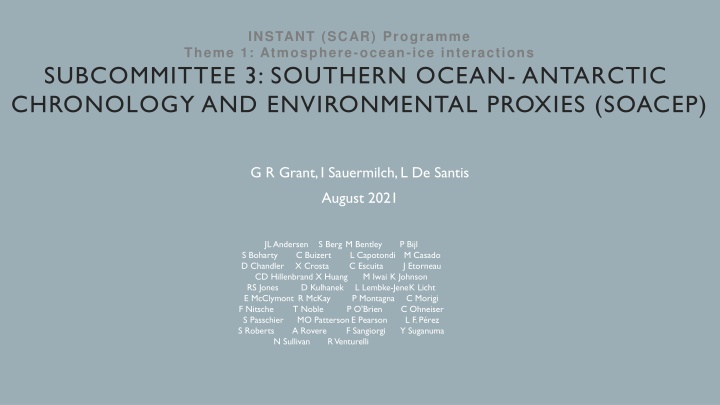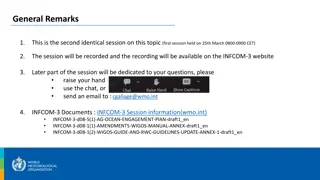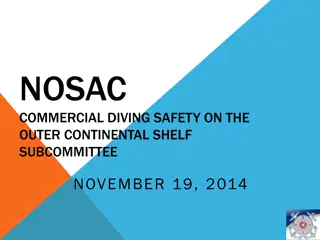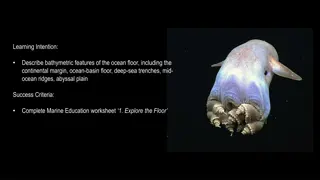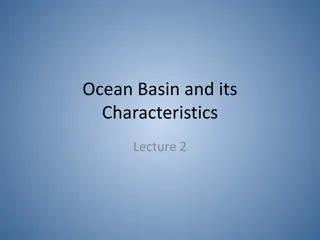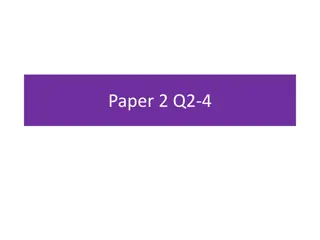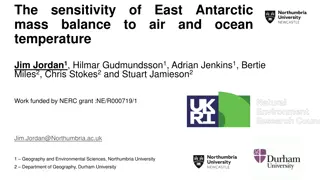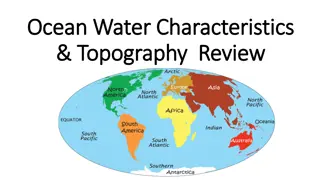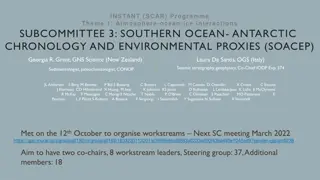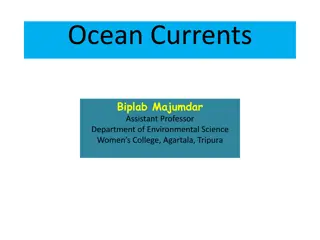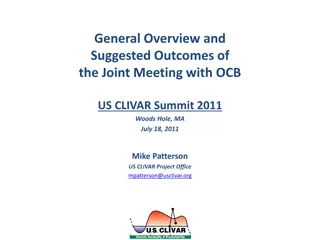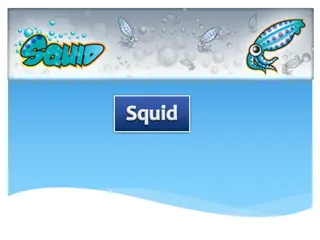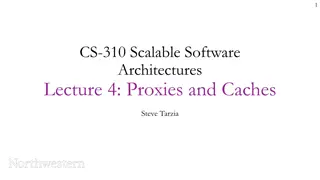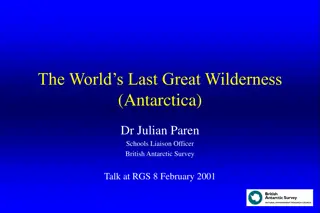Southern Ocean - Antarctic Chronology and Environmental Proxies (SOACEP) Subcommittee Meeting Agenda
The Southern Ocean - Antarctic Chronology and Environmental Proxies (SOACEP) Subcommittee meeting agenda includes introductions, defining workstreams, assigning leaders, setting workplan requirements, and outlining next steps. The committee aims to improve environmental proxies, analyze paleo records, and enhance dating methodologies for a better understanding of environmental changes in the region.
Download Presentation

Please find below an Image/Link to download the presentation.
The content on the website is provided AS IS for your information and personal use only. It may not be sold, licensed, or shared on other websites without obtaining consent from the author.If you encounter any issues during the download, it is possible that the publisher has removed the file from their server.
You are allowed to download the files provided on this website for personal or commercial use, subject to the condition that they are used lawfully. All files are the property of their respective owners.
The content on the website is provided AS IS for your information and personal use only. It may not be sold, licensed, or shared on other websites without obtaining consent from the author.
E N D
Presentation Transcript
INSTANT (SCAR) Programme Theme 1: Atmosphere-ocean-ice interactions SUBCOMMITTEE 3: SOUTHERN OCEAN- ANTARCTIC CHRONOLOGY AND ENVIRONMENTAL PROXIES (SOACEP) G R Grant, I Sauermilch, L De Santis August 2021 JL Andersen S Berg M Bentley S Boharty C Buizert D Chandler X Crosta CD Hillenbrand X Huang RS Jones D Kulhanek E McClymont R McKay F Nitsche T Noble S Passchier MO Patterson E Pearson S Roberts A Rovere N Sullivan P Bijl L Capotondi M Casado C Escuita M Iwai K Johnson L Lembke-Jene K Licht P Montagna P O'Brien J Etorneau C Morigi C Ohneiser L F. P rez Y Suganuma F Sangiorgi R Venturelli
AGENDA 1. Start recording meeting 2. Brief introductions (Georgia, Isabel, Laura) [5min] 3. Intro to subcommittee (IS/LD) and the structure (GG) [10min] 4. Clarify workstreams (all) [15min] 5. Assign workstream leaders (all) [10min] 6. Define first steps and requirements of workplan (all) [15min] 7. Next steps (GG/IS/LD) [5min]
1. BRIEF INTRODUCTIONS (GEORGIA, ISABEL, LAURA) [5MIN] Georgia R. Grant, GNS Science (New Zealand) Sedimentologist, paleoclimatologist, chronologist (biostrat and astrochron) Isabel Sauermilch, Utrecht University (Netherlands) Seismic stratigraphy, geophysics, physical oceanography Laura De Santis, Istituto Nazionale di Oceanografia e di Geofisica Sperimentale (Italy) Seismic stratigraphy, geophysics, Co-Chief IODP Exp. 374
2. SOACEP SUBCOMMITTEE (IS/LD) [8MIN] Identifying, compiling (in interactive format) and analysing paleo proxies used to reconstruct environmental variability throughout the geological past. Identifying key regions around Antarctica, and gaps of knowledge for proxy development and improvements, with consultation of both proxy and modelling community. Documenting chronological methodology and developing systematic assessment of age models for paleo records. Improve the correlation at a continental scale between terrestrial and proximal marine, to deep marine Southern Ocean environmental response through time.
2. SOACEP SUBCOMMITTEE (IS/LD) [8MIN] 1. Identify the paleo-proxies (and critical regions) needed by modelers to answer the key science questions 2. Define the gaps in geographical areas, time periods and proxy understanding 3. Improve the accuracy of existing proxies and develop new precise proxies for quantifying key environmental changes and identifying their drivers 4. Collate and document dating methods, technique uncertainty and environments they can be applied. 5. Undertake a confidence assessment of the dating methods and their uncertainties with guidelines for calculating the propagation of uncertainties. 6. Form a bestpractice for developing age models, reporting uncertainty and formatting guidelines to support subsequent updates to e.g. GPTS, reservoir effects. 7. Investigate a framework to collate all chronostratigraphic (sediment and ice) Antarctic records for open access use by the community.
2. SOACEP SUBCOMMITTEE (IS/LD) [8MIN] Antarctic-specific review paper on existing and new (paleo-)proxies (e.g. those being recently developed like ancient DNA). Antarctic-specific review paper on existing chronology methodologies and best practice for developing age models. Standardization of datasets, protocols for proxy measurements and reporting of analytical results, including sample and data collections Generate interactive location map of available proxy data (e.g., shapefile with metadata for Quantarctica for different time periods; proxy catalogue) StarterKit webpage for early career researchers and cross-disciplinary researchers (including references to key publications, resources for analytical protocols, proxy calibrations and sample repositories, links to existing initiatives and how to easy access information to the variety of scales (time and space) that the proxies and/or models can address Provide an independent stratigraphic framework for correlating paleo-environmental proxies Mostwanted list for proxy records highlighting which environmental data are most crucial for (i) understanding processes, (ii) parameterizing numerical models and (iii) constraining thresholds of major environmental changes, such as partial/total ice-sheet collapse and oceanographic changes. OUTPUT REVIEW/WHITE PAPER STANDARD DATASETS STARTER KIT MAP QUANTARCTICA INSTANT SCHOOL PROGRESS PAPER WORKSHOPS/SESSIONS INSTANTSPECIAL ISSUE 2021 2022 2023 2024 2025 2026 2027 2028 2029
2. SUBCOMMITTEE STRUCTURE (GG) [2MIN] i. Two to three Chairs that generally hold a two-year tenure Self-nominated with supporting references, decided by the current Chairs Coordinate and facilitate workstreams Workstream co-leaders (seven workstreams) ii. Self-nominated from within the steering group, decided by current Chairs Responsible for more detailed coordination of specific tasks Steering group members iii. Self-nominating from the membership (unlimited number) Contribute to workstreams All other members on mailing list iv. Updated with progress
2. SUBCOMMITTEE STRUCTURE (GG) [2MIN] Terms will not be strictly enforced Encourage regular rotation of leaders accounting for continuity Encourage flexible and co-leadership to reduce workload Support pairing of ECR with Mid- Senior Researchers In case of over subscription for roles, importance will be placed on diversity and representation
3. CLARIFY WORKSTREAMS (ALL) [15MIN] https://app.mural.co/t/gnslara0192/m/gnslara0192/1633233113201/e35f59efecd5683a0233a600f43ba495e7045ad9?sender=ggrant5238 On Mural (open till 25th Oct) 7 workstreams could merge 4&5 Outputs for Workstreams 4,5,6 1. 2. 3. 4. Identify paleo-proxies (what and where) needed by modelers Define the gaps in geographical areas, time periods and proxy understanding Improve the accuracy of existing proxies and develop new precise proxies Collate and document dating methods, technique uncertainty and environments they can be applied. Undertake a confidence assessment of the dating methods with guidelines for calculating the propagation of uncertainties. Form a bestpractice for developing age models, Investigate a framework to collate all chronostratigraphy (sediment and ice) 5. 6. 7.
4. NOMINATE WORKSTREAM LEADERS (ALL) [10MIN] On Mural Self-nominated (place name on workstream if interested) Responsible for more detailed coordination of specific tasks Assigned end of October to allow other participants to contribute
5. DEFINE FIRST STEPS AND REQUIREMENTS OF WORKPLAN (ALL) [15MIN] On Mural Identify risks work required for completion
6. NEXT STEPS (GG/IS/LD) [5MIN] Email all Recording Meeting summary Workstream summaries, co-leaders, members Send to mailing list for further contributions (by 25th October) Workstream leaders selected by end October Timeframe for delivery (Workplan, outputs and timeline for end of November) Workstream leaders and Chairs (end of November) Next meeting March
COMMENTS Quick update on the Antarctic Schools: we are planning the next one for May 2022, we definitely have funding for another in 2024, and likely have funding for 2023 as well. Is it worth considering having a workstream (or subcommittee) developing/organizing early career training opportunities? Denise Kulhanek JUNE 2023 in Utrecht MIO proxy and modelling meeting Francesca Building on Taryn's comment, we could perhaps start off with streams 1-3 together and divide into sub sections later once tasks are better defined... ? Marie Cavitte Agree with Taryn about finding an efficient way to navigate streams 1-3 (similar to how streams 4-6 looked) Erin M
